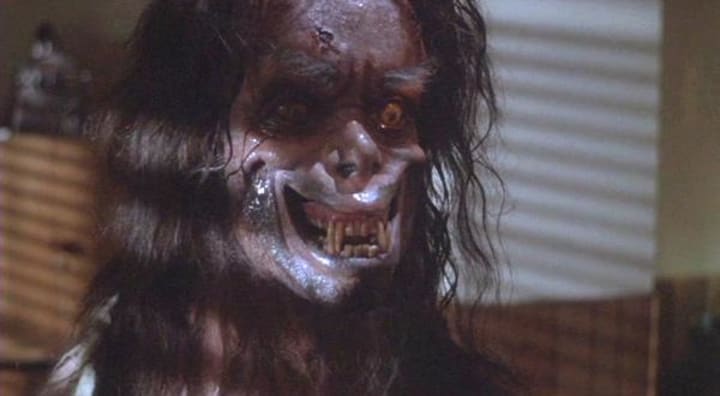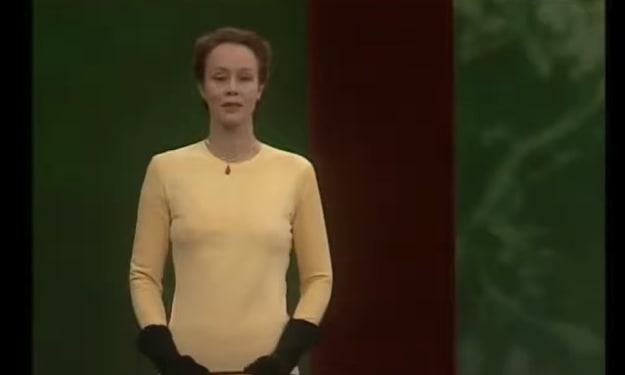
1981 seems to have been the "Year of the Wolf ": Werewolf, that is. In that year alone, three films--The Howling, Wolfen, and An American Werewolf in London--were all released. Of the three, An American Werewolf in London, directed by John Landis, is undoubtedly the most widely popular, if only because of the incredible (for its time) transformation make-up effects sequence created by Rick Baker.
Wolfen was based on a short novel by Whitley Strieber, and perhaps, shouldn't be classed as a "werewolf" picture at all; at least, not in the traditional sense. Strieber is the horror and fantasy novelist turned alien abductee and paranormal researcher. He is either a pioneering genius or a dubious charlatan, based on your perspective. But he's not the subject here.
The Howling, starring Dee Wallace of ET fame, and directed by Joe Dante, who went on to direct Gremlins, is about literal werewolves, in the legendary sense. Dee Wallace plays Karen, a reporter for a sleazy tabloid television program, who begins to receive calls from a suspected psychopath--a serial killer. Enlisting the aid of police, the calls are recorded as Dee is instructed (while standing in an old-fashioned phone booth) to go into a local adult bookstore.
She sits, as per her instructions, in the back, watching the violent sexual domination of a bound-and-gagged woman in an old booth playing porno loops. Behind her, the killer, Eddie (Robert Picardo), is seen only in silhouette. He quickly, though, begins a startling transformation.
The cops enter, and Eddie is shot. Karen falls to the ground but ends up with amnesia. She begins to be troubled by horrific visions of the wolf-like Eddie, and other violent scenes. Her psychiatrist, Dr. Waggner (Patrick Macnee, in a role that is a nod to the first werewolf in English literature, "Wagner the Werewolf," from the 1846 book of the same name) suggests Karen and husband Bill (Christopher Stone) visit some sort of new-age commune called "The Colony."
Waggner personally oversees the colony, which is a mixture of encounter-group yuppies and small-town eccentrics, one of whom is horror legend John Carradine, in a role as a doddering, strange old man with fixations on UFOs and Bigfoot. Another camper, the sexually insatiable Marsha Quist (Eddie's wife, played by the late Elizabeth Brooks) walks around clad in a leather top, with a plunging neckline, long dark hair, and a headband. Right away she sets her sights on Karen's husband.
The couple settles in at the colony. Meanwhile, Karen's investigative reporter friend Teri (Belinda Balaski) and boyfriend Chris (Dennis Dugan) go to visit Eddie's sleazy apartment. Reminiscent of the Night Stalker killer, Richard Ramirez's apartment, Eddie's apartment is small, filthy, and cluttered with his horrifying creature drawings and news clippings of his murders. Later, they discover Eddie's body has disappeared from the morgue.
Bill gets bitten by a werewolf returning from a hunting trip. He and Marsha Quist make love, transforming into werewolves. Chris goes to visit an occult bookstore run by actor Dick Miller (whose character name, "Walter Paisley," is taken from Miller's role in Roger Corman's 1959 film Bucket of Blood. Corman, BTW, has a cameo, along with horror legend Forrest J. Ackerman). Later, he will buy a collection of silver bullets from this same place.

Moonlight Sonata
Looking at the weird scratches on his back, Karen suspects Bill of the affair with Marsha. Weirdly, his character seems to eventually just vanish at this point in the film.
Teri, based on a painting done by Eddie Quist, connects him with the colony. Panicked, she goes there to warn Karen. She is confronted, while going through Waggner's office looking for evidence, by the resurrected Eddie, who, after a transformation scene with a bubbling face and growing fangs and claws, kills Teri by a strike to the jugular.
Chris is on the phone with her at the time (he, incidentally, has a copy of "Howl" by Allen Ginsburg, sitting on his desk). Panicked, he takes his box of silver bullets and goes out to the colony. Eddie, who has also confronted Karen, is burned by her quite badly when she throws acid in his face. But, you can't kill the werewolves, except with a silver bullet.
Chris of course has them. He kills Eddie. Then we get to the surprise ending, although we suspected it all along. The final denouement, a transformation, or rather, revelation, is such a shocking moment, and so satirical at the same time, that, immediately after it occurs, the film should have ended. The outro, of disbelieving blue-collar shmoes drinking at a bar, watching the television news with unbelieving and cynical eyes, has the feel of an empty, cheap joke; a cheap, parting shot, and then, closing credits. Over a frying hamburger steak.
The Howling contains many little tributes, homages to famous horror and werewolf directors of the past, as well as cartoons, products, and even a nod at Wolfman Jack. The special effects of Rob Bottin, for their period, were exciting and surreal; sometimes they DO seem a bit threadbare, especially by modern standards, but this is a minor quibble.
The film passionately seems to celebrate the occult origin of the werewolf legend, all the while framing it in the context of a modern thriller. If there is a subtext here, it is that entering the Reagan Era, with its formulated, domesticated values, its hypocritical consumerism and cynicism, its dislocation from reality, and its condemnation of social deviance (in a culture that was rapidly shifting values regardless) necessitates that anyone with a "secret" goes underground--keep their politics, sexuality, or gender identity is hidden. After all, it is the "other," the alien that is the threat. But, how in the world can you tell just who the threat is? Are subversive radicals and malcontents (i.e. our real-life "werewolves") going to announce themselves publicly? On television? For the world to see?
No.
And even if they did, at the height of our apathy and cynicism, The Howling seems to ask: Would we even believe them?
About the Creator
Tom Baker
Author of Haunted Indianapolis, Indiana Ghost Folklore, Midwest Maniacs, Midwest UFOs and Beyond, Scary Urban Legends, 50 Famous Fables and Folk Tales, and Notorious Crimes of the Upper Midwest.: http://tombakerbooks.weebly.com






Comments
There are no comments for this story
Be the first to respond and start the conversation.